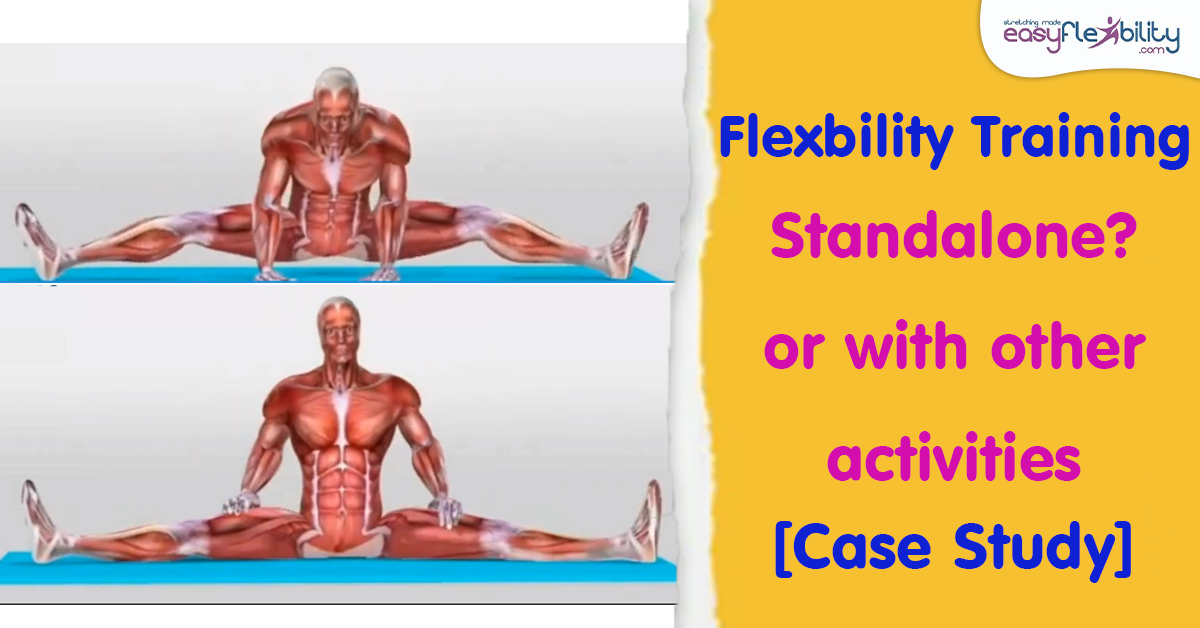Flexibility Training Program: Is it most beneficial standalone or with other fitness activities? [Case Study]


EasyFlexibility conducted a study in August 2022 to delve into this question. We analyzed a broad group of EasyFlexibility users who track their flexibility progress weekly and overall through our Stretch180 app. Our goal was to uncover what influences the rate of flexibility improvement among our users.
One of the key questions we explored was whether it's more beneficial to practice EasyFlexibility exercises on their own or alongside other fitness activities. By comparing the responses with each participant's progress data, we discovered insights that might intrigue you.
In our research on flexibility training effectiveness, participants were presented with two options regarding their training routine. The first option was to practice EasyFlexibility training separately from other activities. The second option allowed for the integration of EasyFlexibility training with another fitness activity within the same session.
Interestingly, the distribution between these choices was roughly 2 to 3. This means that for every two individuals integrating EasyFlexibility with other forms of training, three individuals preferred to focus solely on EasyFlexibility during a workout session.
It's important to note that this finding doesn't imply these individuals excluded other sports or fitness activities from their overall routine; they simply chose to dedicate specific sessions exclusively to EasyFlexibility training.
To analyze the impact of these choices, we compared the progress of participants from both groups using the Stretch180 App. This involved tracking both overall and weekly progress in flexibility, measured in degrees. After eliminating outliers with significant deviations from both groups, we calculated the average progress by summing the degrees of improvement and dividing by the number of participants.
The results
To put this into perspective, an 18.43% improvement rate is significant, nearly 20%. For example, over a span of five weeks, the group focusing solely on EasyFlexibility exercises achieved the same results in about 20% less time. This means that, on average, practitioners who used the EasyFlexibility program exclusively reached their flexibility goals in approximately 4 weeks, compared to 5 weeks for those who mixed their training.
It's crucial to note that this rate of progress varies from individual to individual within each group. The mentioned improvement rate is an average across all participants, whether they practiced EasyFlexibility exercises separately or alongside other activities.
Understanding that this is an average rate of progress is key. It doesn't imply that every individual in the more rapidly improving group outperformed every individual in the slower-progressing group. Just as in sports teams where not every player on the winning team outmatches every player on the opposing team, there might be individuals in the group that combined training who progressed faster than some in the EasyFlexibility-only group.
These findings align with those from previous controlled in-studio studies. The aim of this larger-scale research was to include a broader sample size than what could be accommodated in a studio setting. However, it's important to recognize the limitations of a non-controlled study, as our conclusions are based on progress tracked through the Stretch180 App and participant responses.
A quick discussion about the results
The outcomes observed can be attributed to the structured and targeted nature of EasyFlexibility programs. These programs are meticulously designed, focusing on specific muscles required for certain skills, alongside strength exercises that complement the flexibility goals. This synergy between flexibility and strength is achieved through a carefully planned warm-up and exercise sequence, aiming for a precise objective where each element supports the other.
Incorporating various other exercises into one's routine could potentially disrupt this balance. For instance, engaging in strength training that targets muscles not relevant to the desired flexibility goal could divert the body's energy away from the muscles that are crucial for enhancing flexibility. EasyFlexibility's optimal results are typically seen after completing 5 to 6 rounds of the program, with one round consisting of all the Zaichik Stretching Techniques (ZSTs) and supporting exercises outlined in the program. Engaging in additional activities might lead to a shortfall in energy or time, preventing the completion of the necessary rounds for maximum flexibility gains.
Given the non-controlled nature of this study, it's challenging to determine the specifics of each participant's additional activities. It's conceivable that if the supplementary exercises were in alignment with the EasyFlexibility program, the outcomes might have been more favorable than in the absence of those exercises.
It's important to remember that the impact of combining training varies from person to person. While some might experience a significant slowdown in their flexibility improvements, for others, the effect could be minimal. On average, the slowdown was observed to be around 20%.
To sum up, if you feel confident in your ability to merge EasyFlexibility programs with other exercises effectively, you might consider doing so. However, if you're unsure about how to integrate these programs or if your primary objective is to achieve a specific skill as quickly as possible, it's advisable to focus solely on EasyFlexibility programs. These programs are scientifically crafted to ensure a harmonious development of both strength and flexibility, tailored towards achieving specific goals.



